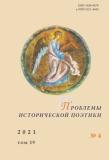Топос «стояние на костях» в древнерусских повествованиях о битвах
The Stoyanie na Kostyakh Topos in Ancient Russian Battle Narratives
Author(s): Lidia V. SokolovaSubject(s): Customs / Folklore, Poetry, Russian Literature, 13th to 14th Centuries, 15th Century, 16th Century, 17th Century, Philology, Hermeneutics
Published by: Петрозаводский государственный университет
Keywords: military narrative; monuments of the Kulikovo cycle; topos; military formula “stal na kostyakh”; military ritual “stoyanie na kostyakh”;
Summary/Abstract: The article presents the analysis of the stoyanie na kostyakh (standing on bones) topos, which is present in battle narratives of the 13th–17th centuries. In battle chronicles this topos is most often expressed by the verbal formula stal na kostyakh (meaning “he has won”), referring either to a prince or to soldiers in general. Instead of the formula stali na kostyakh (they have won), it is sometimes reported how many days the victorious soldiers stoyali na kostyakh, that is, how many days they stayed at the site after the battle. The most interesting use of the topos is revealed in the The Tale of the Battle with Mamai. In this text the fixed expression stal na kostyakh refers to Prince Vladimir Andreevich, whom the author depicts as the main hero of the battle, despite tradition. At the same time, the author provides a detailed account of the stoyanie na kostyakh ritual performed by the victorious soldiers led by Dmitry Ivanovich and reports that “the great prince has been standing on the bones for eight days behind the Don.” Both ancient Russian authors and modern researchers understand the meaning of this ritual reflected in the works of poets and artists in different ways.
Journal: Проблемы исторической поэтики
- Issue Year: 19/2021
- Issue No: 4
- Page Range: 105-148
- Page Count: 44
- Language: Russian

